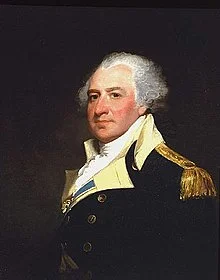Thomas Stone Convinces Maryland to Ratify The Articles of Confederation
Thomas Stone is one of the chosen few who signed the Declaration of Independence.
Later, Stone helped created the Articles of Confederation. He then led a long, difficult battle for the State of Maryland to ratify the Articles and create a united confederation.
Thomas Stone
Thomas Stone had a thirst for knowledge from a very young age.
Despite his family having money, they had too many children to rear to pay for his higher education. Stone was forced to borrowed money to receive his law degree.
Fortunately for him, he became a successful attorney and was able to pay his debts.
Declaration of Independence
Stone joined the local Committee of Correspondence in protest of British activity. He received his first taste of politics when he was elected to the Annapolis Convention, which was Maryland’s Revolutionary Government.
In late 1775 he was selected to attend the Constitutional Convention. As Stone and most of his fellow Maryland delegates were comparatively young, the colony instructed them not to vote for independence because it was too early for that decision to be made.
Luckily, by the following June, feelings had drastically swayed and Maryland updated its instructions. The delegates were permitted to use their best judgment.
Stone enthusiastically began promoting a separation with the Mother Country and in July 1776 voted in favor of the proposal. He signed the Declaration of Independence with his fellow revolutionaries.
Articles of Confederation
Thomas Stone was placed on the committee in charge of drafting a new government. He played a large role in forming the ideas that would become the Articles of Confederation.
Soon after this, he returned to Maryland where he served in the Maryland State Senate.
Stone pushed hard for the adoption of the Articles by his State, though he was fighting a tough battle. At a time when most States considered themselves independent from each other as well as Great Britain, Maryland held fast to the belief that no union was needed at all.
Eventually Stone was able to persuade the majority of Maryland’s representatives of the need for confederation and the Articles were ratified. It may have helped that, since Maryland was the only state who had not yet agreed to the Articles of Confederation, ratification seemed inevitable.
The Death of Margaret Stone
Stone’s wife, Margaret, had visited him while he was a delegate to the Continental Congress. Because there was a smallpox outbreak, she was inoculated against the disease.
At the time, vaccines were still in their early stages of development and were substantially riskier than they are today. Margaret’s inoculation left her sick, and she would remain ill for the rest of her life.
A major reason Thomas Stone resisted attempts to send him back to the Continental Congress was to remain close to his wife and care for her.
Except for one brief trip to Philadelphia (where he spent time as President of the Confederation), Thomas would stay with Margaret in Maryland.
When she passed away in 1787, Thomas was filled with grief. Just a few months later, despite being only 43 years of age, Thomas Stone died. By all account, his cause of death was a broken heart.
If you enjoyed this article, please subscribe to our email list and you will receive a new Founder every day.
If you would like to learn more about Thomas Stone, there is really just one biography of his life. Pick up a copy of 'Elusive Maryland Signer' through our affiliate Amazon by clicking on the link below.






